
All About Famous In jaipurFairs and Festivals of jaipur Makar Sankranti 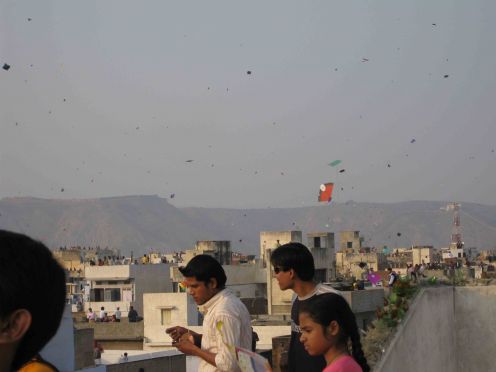 The festival is celebrated on the 14th of January every year. This has now become the festival of kite-flying which does not spare the soaring spirits of anyone in jaipur. The devoted ones, however, take a holy dip in the kund at Galtaji. The traditional sweet associated with it is Phirni, made in abundance by the halwais of jaipur.
The festival is celebrated on the 14th of January every year. This has now become the festival of kite-flying which does not spare the soaring spirits of anyone in jaipur. The devoted ones, however, take a holy dip in the kund at Galtaji. The traditional sweet associated with it is Phirni, made in abundance by the halwais of jaipur. Teej Festival 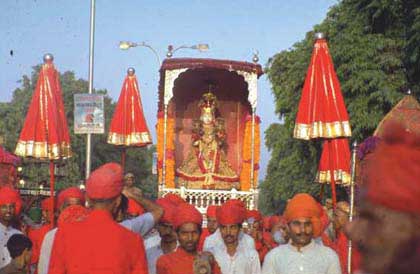 Teej Festival is one of the most popular festivals of India. Festival of Teej is widely celebrated, but its real charm can be found only in jaipur, Rajasthan. Teej celebrates the arrival of monsoon, after the scorching sun of summers. Teej is celebrated in the month of 'Shravan' (July-August), according to the Hindu calendar.
Teej Festival is one of the most popular festivals of India. Festival of Teej is widely celebrated, but its real charm can be found only in jaipur, Rajasthan. Teej celebrates the arrival of monsoon, after the scorching sun of summers. Teej is celebrated in the month of 'Shravan' (July-August), according to the Hindu calendar.Gangaur Festival 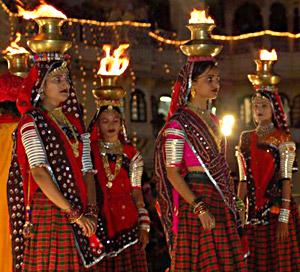 Young girls and newly married women praying for their loved one or husband respectively, offer prayers to Goddess Parvati in spring (March-April). A colourful procession follows the silver and gold palanquins of Goddess Parvati brought out from the City Palace. Ghever, the traditional sweet associated with this festival is prepared all over the city.
Gangaur Festival: The Gangaur festival is the most important local festival of Rajasthan and is observed throughout the state with great fervour and devotion by womenfolk who worship Gauri, the consort of lord Shiva. Gan is a synonym for Shiva and Gauri which stands for Gauri or Parvati who symbolizes saubhagya (Marital Bliss). Gauri is the embodiment of perfection and conjugal love which is why the unmarried women worship her for being blessed with good husbands, while married women do so for welfare, health and long life of their spouses and a happy married life.
The festival commences on the first day of Chaitra, the day following Holi and continues for 18 days. For a newly-wedded girl, it is binding to observe the full course of 18 days of the festival that succeeds her marriage. Even unmarried girls fast for the fully period of 18days and eat only one meal a day.
Images of Isar & Gauri are made of clay for the festival. In some families, permanent wooden images are painted afresh every year by reputed painters called Matherans on the eve of the festival. A distinct difference between the idols of Teej and Gangaur is that the idol will have a canopy during the Teej festival while the Gangaur idol would not a canopy.
The ladies decorate their hands and feet by drawing design with Mehendi (myrtle Paste). The figures drawn range from the sun, Moon and the stars to simple flowers or geometrical designs.
Young girls and newly married women praying for their loved one or husband respectively, offer prayers to Goddess Parvati in spring (March-April). A colourful procession follows the silver and gold palanquins of Goddess Parvati brought out from the City Palace. Ghever, the traditional sweet associated with this festival is prepared all over the city.
Gangaur Festival: The Gangaur festival is the most important local festival of Rajasthan and is observed throughout the state with great fervour and devotion by womenfolk who worship Gauri, the consort of lord Shiva. Gan is a synonym for Shiva and Gauri which stands for Gauri or Parvati who symbolizes saubhagya (Marital Bliss). Gauri is the embodiment of perfection and conjugal love which is why the unmarried women worship her for being blessed with good husbands, while married women do so for welfare, health and long life of their spouses and a happy married life.
The festival commences on the first day of Chaitra, the day following Holi and continues for 18 days. For a newly-wedded girl, it is binding to observe the full course of 18 days of the festival that succeeds her marriage. Even unmarried girls fast for the fully period of 18days and eat only one meal a day.
Images of Isar & Gauri are made of clay for the festival. In some families, permanent wooden images are painted afresh every year by reputed painters called Matherans on the eve of the festival. A distinct difference between the idols of Teej and Gangaur is that the idol will have a canopy during the Teej festival while the Gangaur idol would not a canopy.
The ladies decorate their hands and feet by drawing design with Mehendi (myrtle Paste). The figures drawn range from the sun, Moon and the stars to simple flowers or geometrical designs.Kite Festival 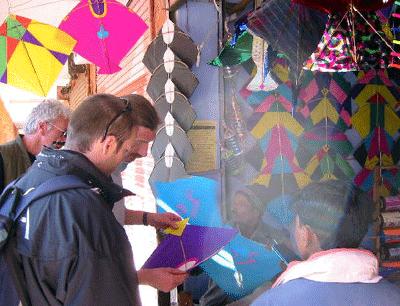 Kite Festival is a popular festival of jaipur, Rajasthan. Kite flying is enjoyed by people of all age-groups. However, 14 January, the day of Makar Sankranti, makes the official day for flying kites in jaipur. People make most out of the festival by flying kites for the whole day.
Kite Festival is a popular festival of jaipur, Rajasthan. Kite flying is enjoyed by people of all age-groups. However, 14 January, the day of Makar Sankranti, makes the official day for flying kites in jaipur. People make most out of the festival by flying kites for the whole day.Elephant Festival 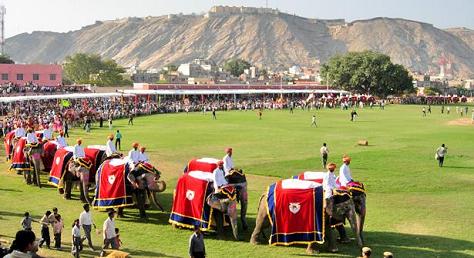 The elephant festival gets underway in the month of Phalgun (March) on the eve of Holi, the festival of colours. The festival begins with a procession of elephants, camels, horses and folk dancers. The sight of mighty jumbos striding majestically is a treat to watch. The mahavats or owners proudly decorate their elephants with bright colours, jhools (saddle cloth) and heavy jewellery. Female elephants are made to wear payals or anklets which tinkle as they walk. Prizes are given for the most beautifully decorated elephant. Even more exciting is the Polo match, the Elephant race, the tug-of-war between elephant and 19 men and women. The most colourful being the playing of Holi on Elephant back.
The elephant festival gets underway in the month of Phalgun (March) on the eve of Holi, the festival of colours. The festival begins with a procession of elephants, camels, horses and folk dancers. The sight of mighty jumbos striding majestically is a treat to watch. The mahavats or owners proudly decorate their elephants with bright colours, jhools (saddle cloth) and heavy jewellery. Female elephants are made to wear payals or anklets which tinkle as they walk. Prizes are given for the most beautifully decorated elephant. Even more exciting is the Polo match, the Elephant race, the tug-of-war between elephant and 19 men and women. The most colourful being the playing of Holi on Elephant back.
Dussehra 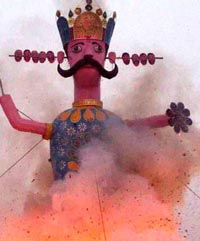 Dussehra is celebrated by staging Ramlila in different parts of the city and cuminating in the ceremonial burning of the giant effigies of Ravan, Kumbhakaran and Meghnath, celebrating Lord Rama's victory over the Demon King, and victory of Good over Evil. A mela is organised at Amer and thousands of devotees visit the templeof Shila Mataji situated there. Special puja is offered by the former Maharaja in the City Palace amidst traditional fanfare. Durga Puja is celebrated in several community pandals for four days by the large Bengali population in the city.
Dussehra is celebrated by staging Ramlila in different parts of the city and cuminating in the ceremonial burning of the giant effigies of Ravan, Kumbhakaran and Meghnath, celebrating Lord Rama's victory over the Demon King, and victory of Good over Evil. A mela is organised at Amer and thousands of devotees visit the templeof Shila Mataji situated there. Special puja is offered by the former Maharaja in the City Palace amidst traditional fanfare. Durga Puja is celebrated in several community pandals for four days by the large Bengali population in the city. Sheetla Mata Fair The Sheetla Mata Fair is held in March-April, the month of Chaitra, in village Seel-Ki-Doongri. Doongri is a hillock on top of which the shrine of Sheetla Mata stands. The Fair is held in her honour every year. The fair attracts hordes of visitors from far and wide. People believe that epidemics spread because of the wrath of Sheetla Mata and hence they worship her and make offerings so that she may be pacified. The deity is represented by a red stone. It is veritable picnic for the pilgrims attending the fair. It is customary to cook one's own food at the site, and eat it only after it has been offered at the shrine. A temporary market comes up at the fair and the rural folk can been trading in wares such as shoes, clothes, food stuff, utensils and agriculture implements. A cattle fair is also organized during the fair. It is a small affair and lasts for about a week. Bullocks, camels and horses are sold at the fair and prizes are awarded to the best breeders. Diwali 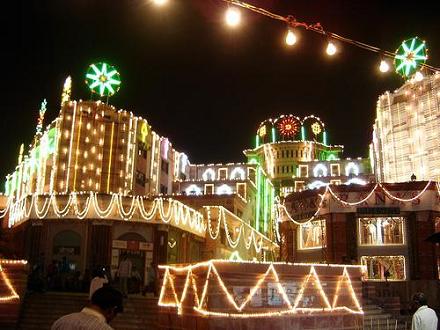 Diwali Celebrated every year in October- November, Diwali is perhaps the most popular of all Indian festivals. The origin of this festival can be traced back to the ancient Hindu epic Ramayana, when Lord Rama returend to this kingdom Ayodhya after 14 years of exile. The whole kingdom was lit up with diyas (earthen lamps ) to celebrate his return. To date, on Diwali day, houses all over India glow with the twinkle of innumerable divas, candles and electric lights. The night is illuminated with the flaming lights of fireworks, creating kaleidoscopic design against the black canvas of the sky. During the Diwali celebration decoration and lighting is done throughout the walled Pink City, with every market competing with the others to pick-up the best decorated market award. There are special prizes for the best decorated individual buildings as well. Most people prefer walking through the street to enjoy this dazzling extravanganza.
Diwali Celebrated every year in October- November, Diwali is perhaps the most popular of all Indian festivals. The origin of this festival can be traced back to the ancient Hindu epic Ramayana, when Lord Rama returend to this kingdom Ayodhya after 14 years of exile. The whole kingdom was lit up with diyas (earthen lamps ) to celebrate his return. To date, on Diwali day, houses all over India glow with the twinkle of innumerable divas, candles and electric lights. The night is illuminated with the flaming lights of fireworks, creating kaleidoscopic design against the black canvas of the sky. During the Diwali celebration decoration and lighting is done throughout the walled Pink City, with every market competing with the others to pick-up the best decorated market award. There are special prizes for the best decorated individual buildings as well. Most people prefer walking through the street to enjoy this dazzling extravanganza. jaipur Textile 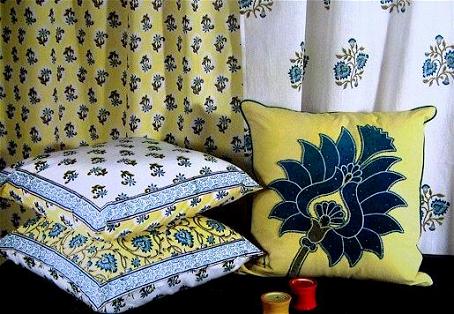 jaipur Handicrafts exporters has the good collection of all type textile ,and we make on client request also as per sample. we have. Cushion Covers Mats Quilts Bed sheets Bandhej Indian Saree Pachmina Shawl.
jaipur Handicrafts exporters has the good collection of all type textile ,and we make on client request also as per sample. we have. Cushion Covers Mats Quilts Bed sheets Bandhej Indian Saree Pachmina Shawl. Indian Paintings India Handicrafts has the good collection of all type Indian painting ,and we make on client request also as per sample. we have. Silk Painting Miniature Painting Cotton Painting Marble Painting Gem Stone Painting Paper Painting. Indian Jewellery 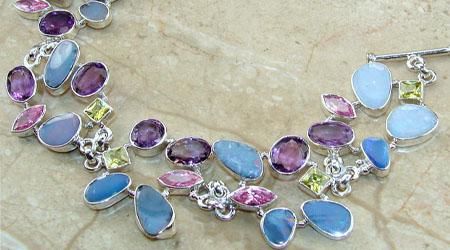 jaipur Handicrafts has the good collection of all type jewellry ,and we make on client request also as per sample. we have.
Silver Jewellery Lac Jewllery Metal Jewellery Fashion jewellery Oxodised Jewellery.
jaipur Handicrafts has the good collection of all type jewellry ,and we make on client request also as per sample. we have.
Silver Jewellery Lac Jewllery Metal Jewellery Fashion jewellery Oxodised Jewellery. Pottery  The royalty of jaipur always appreciated variety handicrafts during their times. Keeping the traditions alive, jaipur is always active in providing the best handicrafts of India. Talking about pottery, glazed blue pottery of jaipur is very famous. Originated in Persia, this kind of pottery includes pots, surahis, mugs, jugs, plates, decorative pieces and many other things. Blue color in pottery offers a trendy look to the things. You can always make a good bargain while buying such stuff.
The royalty of jaipur always appreciated variety handicrafts during their times. Keeping the traditions alive, jaipur is always active in providing the best handicrafts of India. Talking about pottery, glazed blue pottery of jaipur is very famous. Originated in Persia, this kind of pottery includes pots, surahis, mugs, jugs, plates, decorative pieces and many other things. Blue color in pottery offers a trendy look to the things. You can always make a good bargain while buying such stuff. Metal Work jaipur has a decent variety of metal work and it is particularly famous for its brass work. The brass workers of jaipur are skilled in infusing charisma into the dull metal. Lacquered brass and carved brass are two kinds of work that are done on brass in jaipur. You can buy statues and decorative pieces of immaculate quality at a good price from jaipur that will add a class to your drawing room. Marble Work 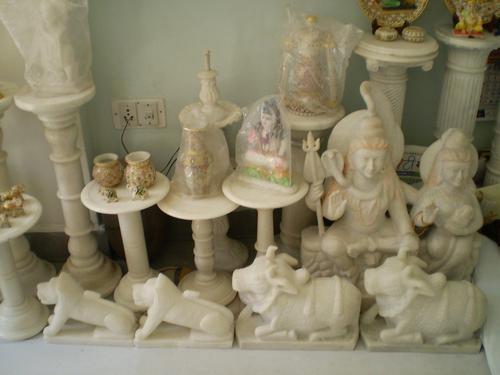 This royal city offers the world-class quality of marble work with intricate carvings. The carvings and portraits, shaped in jaipur, procure a great admiration everywhere. In marble work, you can see the Marble statues of Hindu deities, animals, Human figurines, carved marble bowls and exquisite vases. These are some of the best buys in jaipur markets.
This royal city offers the world-class quality of marble work with intricate carvings. The carvings and portraits, shaped in jaipur, procure a great admiration everywhere. In marble work, you can see the Marble statues of Hindu deities, animals, Human figurines, carved marble bowls and exquisite vases. These are some of the best buys in jaipur markets.Woodwork This pink city has immense variety of handicrafts and to continue the list, here we have woodwork. The fine quality of woodwork in jaipur embraces carved doors, windows, drawer chests, picture frames and mirror frames. The delicate handcrafted woodwork of jaipur has an antique look as they are crafted on traditional lines. Birla Lakshmi-Narayan Temple 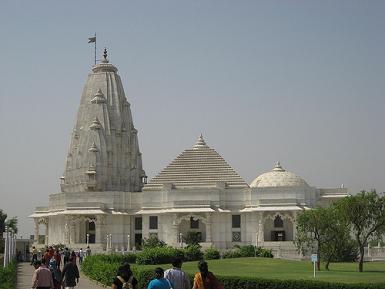 Birla Mandir or the Lakshmi Narayan Temple, situated just below the Moti Dungari. This is a modern temple built of white marble on top of a hill, dominating the skyline of south jaipur. The Birlas (industrialists who have also built several temples in India) built this temple. The temple has been constructed in white marble and has three domes, each portraying the different approaches to religion. The presiding deities here are Vishnu (One of the Hindu Trilogy Gods) called Narayan and his consort Lakshmi Goddess of wealth and good fortune. The temple is built is white in marble and exterior has carved sculptures of various mythological themes and images of saints. The interior has large panel in marble of mythological proceedings. The images of the deities are placed in the sanctum sanctorum. Built on raised ground, it is surrounded by large lush green gardens.
Birla Mandir or the Lakshmi Narayan Temple, situated just below the Moti Dungari. This is a modern temple built of white marble on top of a hill, dominating the skyline of south jaipur. The Birlas (industrialists who have also built several temples in India) built this temple. The temple has been constructed in white marble and has three domes, each portraying the different approaches to religion. The presiding deities here are Vishnu (One of the Hindu Trilogy Gods) called Narayan and his consort Lakshmi Goddess of wealth and good fortune. The temple is built is white in marble and exterior has carved sculptures of various mythological themes and images of saints. The interior has large panel in marble of mythological proceedings. The images of the deities are placed in the sanctum sanctorum. Built on raised ground, it is surrounded by large lush green gardens.Govind Dev Ji Temple 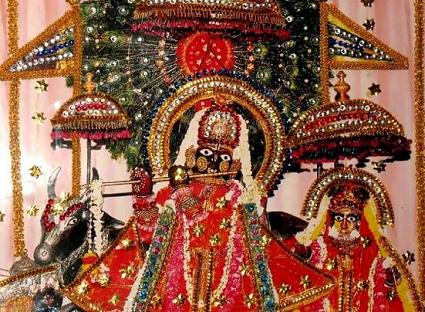 A vital part of the city Palace complex, this Krishna temple has been highly preserved by the erstwhile royal family. Sawai Jai Singh installed the image of GOVIND DEV JI(an incarnation of lord Krishna) after it was brought from Vrindavan. Housed within the sanctum of this spire less temple, the patron deity of the royal family is very religiously worshipped by most of the Hindus in the city and near by areas. The image is unveiled seven times daily for 'AARTIES' and BHOGS offered in the silver wares, consisting of sweets mostly. The idols of RADHA KRISHNA are dressed in different styles each time for the 'AARTI' procession where thousands of followers or 'Bhakt' gather around the courtyard for the Darshan (a look connecting them with the divine).
A vital part of the city Palace complex, this Krishna temple has been highly preserved by the erstwhile royal family. Sawai Jai Singh installed the image of GOVIND DEV JI(an incarnation of lord Krishna) after it was brought from Vrindavan. Housed within the sanctum of this spire less temple, the patron deity of the royal family is very religiously worshipped by most of the Hindus in the city and near by areas. The image is unveiled seven times daily for 'AARTIES' and BHOGS offered in the silver wares, consisting of sweets mostly. The idols of RADHA KRISHNA are dressed in different styles each time for the 'AARTI' procession where thousands of followers or 'Bhakt' gather around the courtyard for the Darshan (a look connecting them with the divine).Moti Dungri ,Ganesh Temple 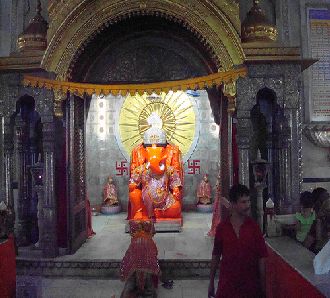 In the middle of jaipur rises a small hill Moti Dungri meaning pearl hill, because it looks hill a drop of pearl. An exotic palace is parched which is a replica of Scottish castle once occupied by Maharaja Madho Singh's son. From There on remained as a private property of the ruling family. In the recent past it served as a home for Rajmata Gaytri Devi and her estranged son Jagat Singh. The mere view of this castle is exotic enough. The highlight of this place is the famous and auspicious temple of Lord Ganesh, which is frequently visited by almost whole of jaipur and people from outside.
In the middle of jaipur rises a small hill Moti Dungri meaning pearl hill, because it looks hill a drop of pearl. An exotic palace is parched which is a replica of Scottish castle once occupied by Maharaja Madho Singh's son. From There on remained as a private property of the ruling family. In the recent past it served as a home for Rajmata Gaytri Devi and her estranged son Jagat Singh. The mere view of this castle is exotic enough. The highlight of this place is the famous and auspicious temple of Lord Ganesh, which is frequently visited by almost whole of jaipur and people from outside.
Raj Mandir Cinema 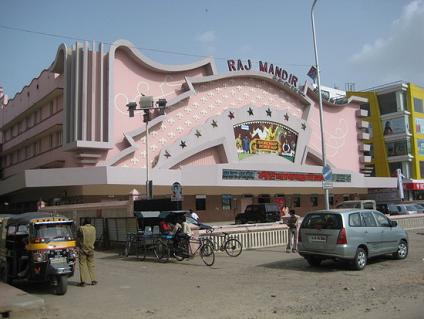 Raj Mandir Cinema
Raj Mandir Cinemajaipur, Raj. Ph. : 01412379372 The Raj Mandir Cinema opened on 1st June 1976 with the film "Charas". It was designed by architect W.M. Namjoshi in a spectacular Art Moderne style. The exterior of the building consists of various asymetrical shapes, zig-zags, curves and even stars set into the facade, all lit at night by concealed lighting. The theatre's name is located on top of the building in large red neon letters and it also boasts the legend 'The Showplace of the Nation - Experience the Excellence'. In the large foyer there are chandeliers set into domes in the ceiling. A large ramp (rather than stairs) take patrons up into the balcony area. Seating in the auditorium is provided in stalls and balcony areas. The decoration in the auditorium is awesome, with indirect lighting that changes colours, hidden behind and underneath a frond fern leaf-like plaster trough which has openings all over the ceiling and walls. The cinema is equipped to screen 70mm films. The Raj Mandir Cinema is the best known cinema building in India and is also on the tourist trail for visitors to jaipur. |

